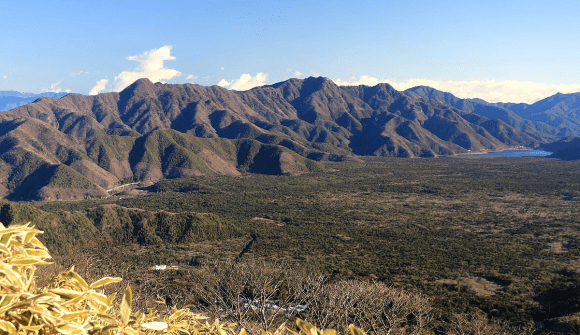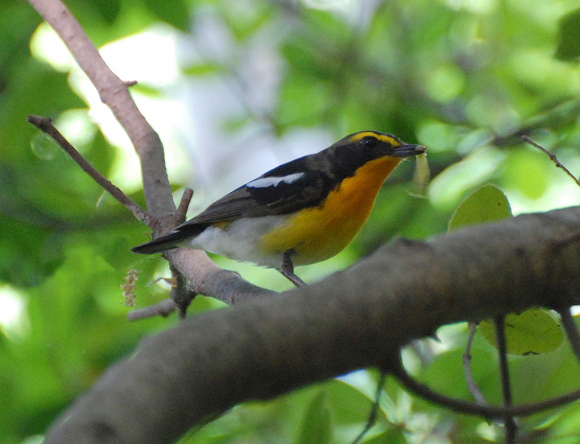
Visitors are discovering that the “sea of trees” near Mt. Fuji is a wonderful place full of natural life.
By many criteria, Yamanashi Prefecture’s Aokigahara seems like it should be a top tourism destination in Japan. The vast forest covers some 30 square kilometers (12 square miles) and is so lush that it’s referred to in Japanese as a jukai, meaning “sea of trees.” Add in its proximity to Mt. Fuji and Lakes Kawaguchi and Sai, and Aoikigahara has all the makings of a prime location for outdoor activities.
▼ Aokigahara
https://twitter.com/abcde4963/status/945816315486523393However, Aoikigahara has also long been considered a prime location for suicides. While rumors of compasses being unusable in Aokigahara due to volcanic rock (the forest stands on hardened lava that flowed down from Mt. Fuji following an eruption more than a thousand years ago) or mournful spirits are urban legends, the forest is dense and secluded enough that it’s very easy to get lost, adding to its stigma as a foreboding place. Suicide-prevention signs, often asking the reader to think of their family, can even be found along certain paths.
But as the images here show, Aokigahara is also undeniably beautiful, and it may finally be shaking off some of its dark reputation. Saiko Yacho no Mori Kouen, a bird sanctuary in Aokigahara, holds an annual nature walk event each summer, taking groups of 5 to 10 people along trails and out of the harsh heat of the Japanese summer. This year, approximately 350 people (including families with children) gathered for the event, with roughly 50 participants coming from outside the prefecture, the first time ever for non-Yamanashi residents to take part.
In 2007, Fuji Kawaguchikomachi, one of the towns which contains part of Aokigahara, began a program to train nature guides for tours of the forest, initially attracting some 5,000 visitors. In 2015, the town welcomed 17,000 Aokigahara visitors, and annually the number of tourists has stayed above 10,000 since, with a total of 30 guides ready to show them Aokigahara’s flora and fauna, which includes migratory birds such as the narcissus flycatcher.
With winter coming, local ryokan inns and tourism organizations are planning a variety of special winter tours as well, as Aokigahara seeks to follow in the footsteps of other parts of the country which want themselves to be a destination for something less tragic than they were before.
Source: Yahoo! Japan News/Mainichi Shimbun via Jin
Top image: Wikipedia/トトト
Insert images: Wikipedia/Alpsdake, Wikipedia/Kuribo



 Japanese Twitter reacts to Logan Paul’s “Japanese Suicide Forest” video
Japanese Twitter reacts to Logan Paul’s “Japanese Suicide Forest” video Japanese YouTuber joins calls to delete Logan Paul’s YouTube account 【Video】
Japanese YouTuber joins calls to delete Logan Paul’s YouTube account 【Video】 Hike from the sea to the peak of Mt. Fuji with new bilingual English/Japanese guide map series
Hike from the sea to the peak of Mt. Fuji with new bilingual English/Japanese guide map series Don’t let the rain get you down! Here are Japan’s top 10 most beautiful rainy day travel spots
Don’t let the rain get you down! Here are Japan’s top 10 most beautiful rainy day travel spots Fuji Dream Airlines is offering limited Mt. Fuji sightseeing flights
Fuji Dream Airlines is offering limited Mt. Fuji sightseeing flights Foreigner’s request for help in Tokyo makes us sad for the state of society
Foreigner’s request for help in Tokyo makes us sad for the state of society Japanese city loses residents’ personal data, which was on paper being transported on a windy day
Japanese city loses residents’ personal data, which was on paper being transported on a windy day Mt. Koya planning to instate visitor’s tax to cope with huge tourist numbers
Mt. Koya planning to instate visitor’s tax to cope with huge tourist numbers Osaka governor suggests lowering voting age to 0 to curb population decline
Osaka governor suggests lowering voting age to 0 to curb population decline Suntory x Super Mario collaboration creates a clever way to transform into Mario【Videos】
Suntory x Super Mario collaboration creates a clever way to transform into Mario【Videos】 Akihabara pop-up shop sells goods made by Japanese prison inmates
Akihabara pop-up shop sells goods made by Japanese prison inmates Ghibli Park now selling “Grilled Frogs” from food cart in Valley of Witches
Ghibli Park now selling “Grilled Frogs” from food cart in Valley of Witches Is Japan’s massive Shizuoka steak sandwich really as delicious as it looks in promo photos?
Is Japan’s massive Shizuoka steak sandwich really as delicious as it looks in promo photos? Red light district sushi restaurant in Tokyo shows us just how wrong we were about it
Red light district sushi restaurant in Tokyo shows us just how wrong we were about it Pokémon Sleep camping suite and guestrooms coming to Tokyo Hyatt along with giant Snorlax burgers
Pokémon Sleep camping suite and guestrooms coming to Tokyo Hyatt along with giant Snorlax burgers McDonald’s new Happy Meals offer up cute and practical Sanrio lifestyle goods
McDonald’s new Happy Meals offer up cute and practical Sanrio lifestyle goods Japanese ramen restaurants under pressure from new yen banknotes
Japanese ramen restaurants under pressure from new yen banknotes French Fries Bread in Tokyo’s Shibuya becomes a hit on social media
French Fries Bread in Tokyo’s Shibuya becomes a hit on social media Studio Ghibli releases new action figures featuring Nausicaä of the Valley of the Wind characters
Studio Ghibli releases new action figures featuring Nausicaä of the Valley of the Wind characters New private rooms on Tokaido Shinkansen change the way we travel from Tokyo to Kyoto
New private rooms on Tokaido Shinkansen change the way we travel from Tokyo to Kyoto Tokyo Tsukiji fish market site to be redeveloped with 50,000-seat stadium, hotel, shopping center
Tokyo Tsukiji fish market site to be redeveloped with 50,000-seat stadium, hotel, shopping center All-you-can-drink Starbucks and amazing views part of Tokyo’s new 170 meter-high sky lounge
All-you-can-drink Starbucks and amazing views part of Tokyo’s new 170 meter-high sky lounge Beautiful Ghibli sealing wax kits let you create accessories and elegant letter decorations【Pics】
Beautiful Ghibli sealing wax kits let you create accessories and elegant letter decorations【Pics】 Studio Ghibli releases Kiki’s Delivery Service chocolate cake pouches in Japan
Studio Ghibli releases Kiki’s Delivery Service chocolate cake pouches in Japan New definition of “Japanese whiskey” goes into effect to prevent fakes from fooling overseas buyers
New definition of “Japanese whiskey” goes into effect to prevent fakes from fooling overseas buyers Our Japanese reporter visits Costco in the U.S., finds super American and very Japanese things
Our Japanese reporter visits Costco in the U.S., finds super American and very Japanese things Studio Ghibli unveils Mother’s Day gift set that captures the love in My Neighbour Totoro
Studio Ghibli unveils Mother’s Day gift set that captures the love in My Neighbour Totoro More foreign tourists than ever before in history visited Japan last month
More foreign tourists than ever before in history visited Japan last month New Pokémon cakes let you eat your way through Pikachu and all the Eevee evolutions
New Pokémon cakes let you eat your way through Pikachu and all the Eevee evolutions Sales of Japan’s most convenient train ticket/shopping payment cards suspended indefinitely
Sales of Japan’s most convenient train ticket/shopping payment cards suspended indefinitely Sold-out Studio Ghibli desktop humidifiers are back so Totoro can help you through the dry season
Sold-out Studio Ghibli desktop humidifiers are back so Totoro can help you through the dry season Japanese government to make first change to romanization spelling rules since the 1950s
Japanese government to make first change to romanization spelling rules since the 1950s Ghibli founders Toshio Suzuki and Hayao Miyazaki contribute to Japanese whisky Totoro label design
Ghibli founders Toshio Suzuki and Hayao Miyazaki contribute to Japanese whisky Totoro label design Doraemon found buried at sea as scene from 1993 anime becomes real life【Photos】
Doraemon found buried at sea as scene from 1993 anime becomes real life【Photos】 Tokyo’s most famous Starbucks is closed
Tokyo’s most famous Starbucks is closed One Piece characters’ nationalities revealed, but fans have mixed opinions
One Piece characters’ nationalities revealed, but fans have mixed opinions We asked a Uniqlo employee what four things we should buy and their suggestions didn’t disappoint
We asked a Uniqlo employee what four things we should buy and their suggestions didn’t disappoint Princesses, fruits, and blacksmiths: Study reveals the 30 most unusual family names in Japan
Princesses, fruits, and blacksmiths: Study reveals the 30 most unusual family names in Japan Mt. Fuji jelly makes Japan’s most famous mountain a delight to look at and taste!
Mt. Fuji jelly makes Japan’s most famous mountain a delight to look at and taste! Japan’s 30 best travel destinations, as chosen by overseas visitors
Japan’s 30 best travel destinations, as chosen by overseas visitors Microsoft pulls game inspired by Logan Paul’s infamous suicide forest video from Xbox Store
Microsoft pulls game inspired by Logan Paul’s infamous suicide forest video from Xbox Store Japan dominates the list of most visited Google Street View locations in Asia
Japan dominates the list of most visited Google Street View locations in Asia Mt. Fuji looks more like a suibokuga painting than real life in this amazing photo
Mt. Fuji looks more like a suibokuga painting than real life in this amazing photo Turn a glass of beer into an exquisite Mt. Fuji scene with this Awakumo glass!
Turn a glass of beer into an exquisite Mt. Fuji scene with this Awakumo glass! Laser-cut, 360-degree “book” lets you bring Mt. Fuji into your home
Laser-cut, 360-degree “book” lets you bring Mt. Fuji into your home Photos of “everyday life” in the town next to Mt. Fuji look like a beautiful fantasy world
Photos of “everyday life” in the town next to Mt. Fuji look like a beautiful fantasy world Peach juice served fresh out the tap at Mt. Fuji Shizuoka Airport
Peach juice served fresh out the tap at Mt. Fuji Shizuoka Airport Barricades placed on Mt. Fuji as mountain officially closes because of coronavirus【Video】
Barricades placed on Mt. Fuji as mountain officially closes because of coronavirus【Video】 10 gorgeous, must-visit places to see the autumn leaves in Japan
10 gorgeous, must-visit places to see the autumn leaves in Japan Japan to reexamine individual traveler ban, politician says current relaxations insufficient
Japan to reexamine individual traveler ban, politician says current relaxations insufficient Amazing photos show Mt. Fuji looking just like an ukiyo-e woodblock painting
Amazing photos show Mt. Fuji looking just like an ukiyo-e woodblock painting Free Wi-Fi is coming to Mt. Fuji this summer
Free Wi-Fi is coming to Mt. Fuji this summer
Leave a Reply